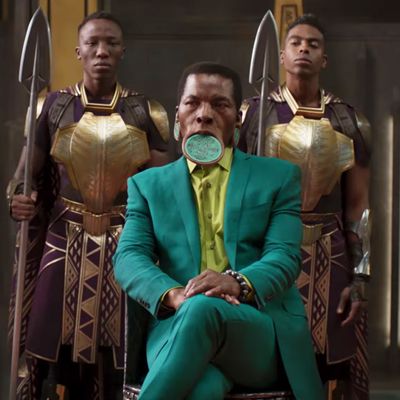
When you think of Wakanda, the futuristic African country that is the setting of Ryan Coogler’s smash-hit superhero movie Black Panther, you can’t help but picture its fabulously dressed citizens. Two-time Oscar nominee Ruth E. Carter is the costume designer responsible for Wakanda’s sartorial splendor, and she’s loving the audience response to her work: Whether it’s at Comic-Con or at the movie theater, people are dressing up as young king T’Challa (Chadwick Boseman), as well as his friends and foes.
“I think in part due to Ryan Coogler’s direction of this piece, and Marvel’s ability to support it in the way that only they could support a piece like this, I was able to touch people with the artistry of Africa,” said Carter. “I’ve been doing this for 30 years, and they’re honoring me back by being in costume, by dressing the part, and by showing me their versions of what I have presented.”
Below, Carter walks us through eight of the film’s most memorable looks, detailing her inspirations and spilling some fun secrets in the process.
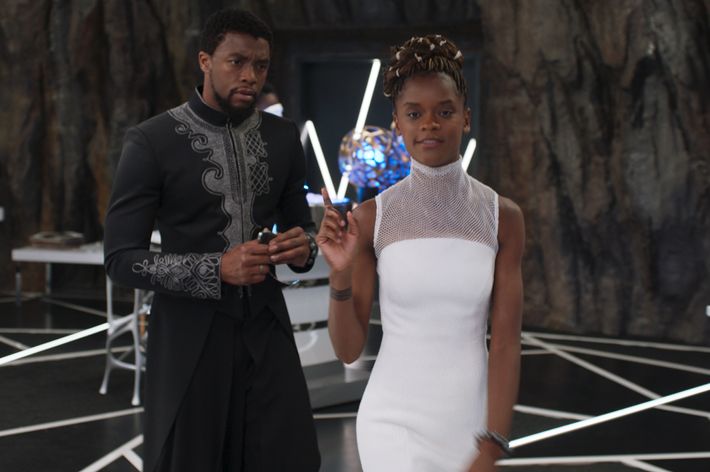
Shuri and T’Challa
As T’Challa’s sister Shuri, Letitia Wright wears so many fabulous outfits in Black Panther that this article could easily be restricted to her eight best looks, but how fair would that be to the other characters? In this particular scene, the siblings’ dress reveals key differences in their attitudes: T’Challa roots his look in tradition, while Shuri is a carefree innovator. That white dress she’s wearing isn’t just a beautiful garment, it’s a high-fashion update of something the science-minded Shuri would be expected to don whenever she peers into a microscope. “I was faced with the challenge of the ‘lab coat’ and I felt like it was so cliché,” said Carter. “Any time someone says, ‘We’re in the lab,’ people go, ‘Well, get the lab coat!’”
Instead, Carter fashioned this strapless dress and gave it a mesh overlay that subtly suggests a lab coat and also feels like something that Shuri would have invented herself. “There’s a wavy pattern in the texture of the mesh so it’s not just a normal fishnet,” said Carter. “I love the idea of presenting fabrics that are appealing and subtle and look like they could have been recycled, and I thought that was so perfect for Shuri. That this is Wakanda, and they’re very eco-friendly, and they care about their country and their environment. She would be the one that would figure out a way to create a vibrant fabric that was a result of recycling.”
For T’Challa, Carter created a cutaway coat based on 18th-century designs and embroidered the front panel and sleeves in a Nigerian style. “I wanted him to have this look of a king and also a military leader,” said Carter. “He has that Wakandan kingly drape that moves around very elegantly, and we see it on him early, when he’s walking with Nakia through the town. Everyone else around him is dressed in full-out colors and Afropunk, and it separates him and presents him as the king.”
T’Challa’s style also makes him a frequent target for his irreverent sister, never more so than when Shuri mocks his sandals by exclaiming, “What are those?” Turns out, they’re luxe Alexander McQueen shoes with a backstop added by Carter. “Everybody laughs at that sandal, but I’m on his side!” said Carter. “I knew it was a part of the joke, but I didn’t pick a sandal that I felt was funny. But it did work. Everybody laughs when they see that sandal. I’m like, ‘What’s wrong with it?’ I can’t figure it out.”
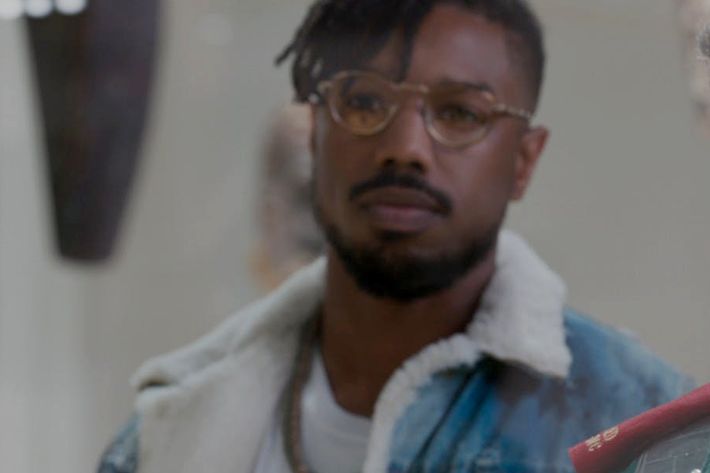
Erik Killmonger
Michael B. Jordan’s “museum bae” look immediately lit the internet on fire when Black Panther’s trailer was released, but Carter says he could have been costumed very differently: In an earlier draft of the script, Jordan’s Killmonger was an anthropologist, and Carter wasn’t quite sure how to make that work. “When you think of an anthropologist, you think of a guy in a sport coat and slacks,” said Carter. “And I was like, ‘How is that going to work on Michael B. Jordan?’ I couldn’t get my head around it. And then Ryan Coogler was like, ‘No, he’s gotta represent the urban lifestyle, urban consciousness, and be unapologetic.’”
The result is a distinctive look that incorporates a shearling jean jacket, Balmain military boots, and a couple of extra touches that thrilled Carter’s director. “We gave him some drop-crotch pants because Ryan Coogler loves a drop-crotch pant,” said Carter, who also added grills and glasses to the final look. “We’ve never seen Michael B. Jordan wearing eyeglasses like that! Ryan Coogler went to the moon every time he saw him in these glasses — he would just laugh. You could just see by the look on his face that he felt it was so right.”
Killmonger’s look throws off the other people at the museum, who fatally underestimate the man in front of them. “Security guards gather around him, because the silhouette is not necessarily normal to see on a learned man,” said Carter. “They’re making some assumptions about him based on his swagger and his urban style.” What they don’t realize is that his street fashion is as high-end as clothes get. “If we were to show them the price tag on all of his pieces, we’d be well into the thousands before we even got to the T-shirt,” said Carter. “He’s that guy who we see all the time where they have style, they have swagger, they have money in their pocket — and he is the direct opposite of Chadwick’s character as a child. So that set you up right away for the hero and the bad guy.”
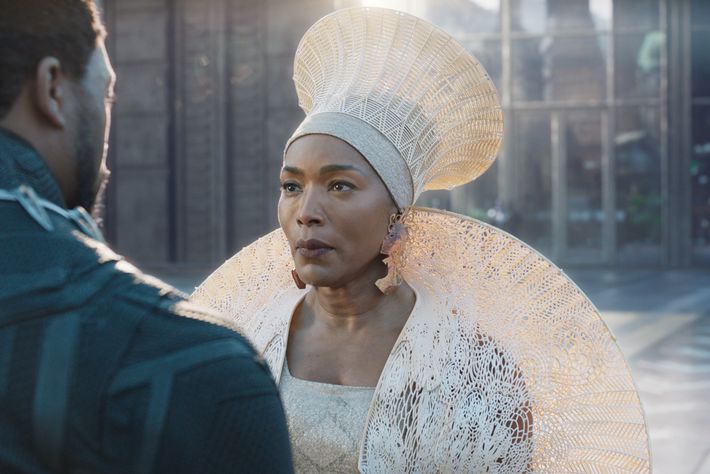
Queen Ramonda
“I have dressed Angela Bassett as a queen so many times,” said Carter, who costumed the actress in Malcolm X and What’s Love Got to Do With It. Still, this was the first time Bassett would be playing literal royalty as T’Challa’s mother, Queen Ramonda, and Carter went all-out to ensure she made a striking first impression. “I wanted to present an image that was the quintessential queen — hands down, no mistaking it. And I feel like when she’s introduced, you know exactly who she is because she has shoulder mantle, this crown, and this big dress. Her silhouette is very, very much of the Queen of Wakanda.”
Bassett’s crown is inspired by a Zulu flared hat, with the cylindrical shape that Carter made a Wakanda motif. To give the hat and shoulder mantle a futuristic feel, Carter conscripted architect Julia Koerner, who is leading the way in making 3D-printed wearable art. “She is the queen of Wakanda and they are forward-thinking in technology, so her crown would have been crafted in the most forward-thinking manner,” said Carter. “The triangles are perfect, the shape of the circle is perfect, and the only way you could achieve that is by doing it on computer and have it printed in a 3D printer.”
Ultimately, the outfit is one of Black Panther’s most striking, mixing African tradition with cutting-edge technology and adding a dash of fairy-tale magic. “It’s like you’re a little girl, and you’re being read a story where there’s a queen and a king or a princess,” said Carter. “That’s how that image speaks to you.”
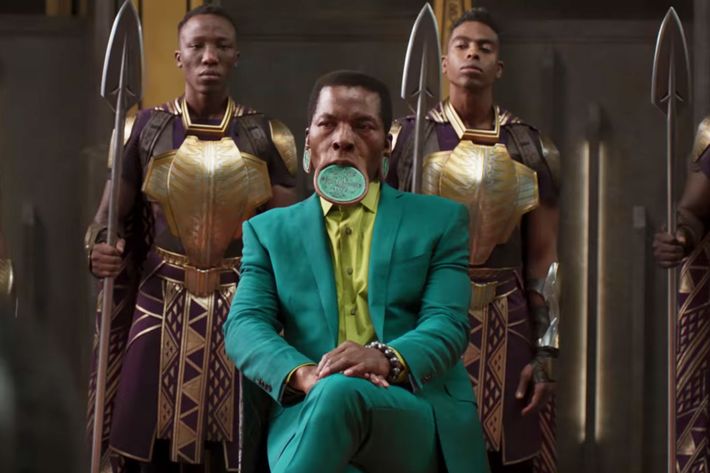
The River Tribe elder
This elder statesman of Wakanda (played by Isaach de Bankolé) may not get much screen time, but his look is unforgettable, one of Carter’s savviest updates of African tradition and contemporary high fashion. “We wanted to connect him to his tribe by giving him his green color, and I remember researching the fashion designer Ozwald Boateng and he has a green suit that has this wonderful tribal print in it all over,” said Carter. The Ghana-descended Boateng is one of Britain’s best-known fashion designers, and Carter called him up in London to ask if he could adapt his suit for the film: “He said, ‘The fabric is made in Milan and takes six months to hand-make it.’ I was like, ‘Seriously? I have two weeks!’ So I just thought, Okay, let me just buy something off the rack.” Fortunately, Carter found the Boateng suit in stores, and matched it with a shirt that’s also from the designer. “Boateng has such an elegance to his clothes, and such a beautiful craftsmanship to the work,” Carter said.
At the last minute, Carter continued to play with elements of the look: Originally, de Bankolé was meant to wear a tie, “but it felt too Western” and he was stripped of it on the day of shooting. One thing that never changed, though, was the elder’s distinctive lip plate. “The lip plate is mainly used by African women, although men do adorn it, and the bigger the lip plate, the more prominence that you have in the tribe,” said Carter. “Usually we see this lip plate in National Geographic on women with no tops who are sitting on the ground, and here he is with his legs crossed and a beautiful suit by the fashion designer Ozwald Boateng. He is bringing so much pride and so much honor to it.”
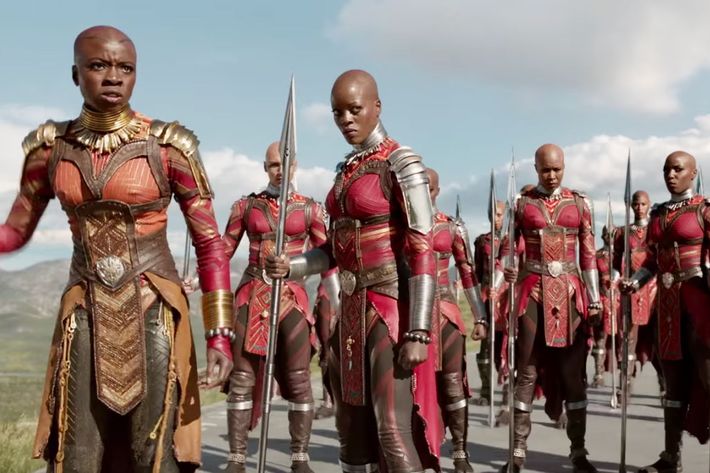
Okoye and the Dora Milaje
“When the Dora Milaje come on the set, you can hear them coming, and it’s exciting,” said Carter of T’Challa’s fierce, female squad of security guards. Finding the right way to make these costumes both stunning and practical posed the biggest challenge for Carter and her crew, and since the actresses had to fight in their outfits, “we were learning as we were going,” said Carter, who would sometimes pop the Dora Milaje neck rings and armbands on and off using velcro. It was also important to Carter to keep T’Challa’s army covered up, since in her opinion, the scantily-clad superheroine has been done to death. “We needed to present another female warrior that was fully clothed with her vitals protected,” Carter said. “She’s really, truly ready for battle.”
Again, Carter drew from African tradition to texture the Dora Milaje uniform. “All of the line work you see on the body and on the arms, it speaks to that sacred geometry that you see all over Africa, when the beads have little stripes going horizontal and vertical,” she said. “I love the way African artistry mixes a lot of patterns: You can have lines and then you’ll have boxes, and then you’ll have triangles and lines again. In that way, I really wanted to mix the textures and the patterns, and the vibrancy of the red was very important.” Carter found herself inspired by the bright and beautiful reds of the Turkana and Maasai tribes, and she was struck by how well it worked on the Dora Milaje: “If you see four or five of them, it could feel like you’re seeing 10 or 20 women, and the color has a lot to do with it.”
Carter also likened the Dora Milaje to a samurai squad, and outfitted them accordingly. “Just like you would see a samurai uniform, their uniform needed to also have the hand-crafted element to it so that it felt like something that has been around for centuries, that the uniform was passed out to them and they could pass it down to their children,” said Carter, who also added bits of jewelry to make each soldier distinctive in her own way. “I put little talismans on them, and you can see them in this picture. I felt like each girl could have something on her tabard that personalized it for her, and maybe represented the tribe that she came from: Some of them might have a fertility doll, a piece of amethyst, or a piece of jade.” The jewelry also could convey a sort of military rank, which is why you might spy adornments on Okoye (Danai Gurira) in an early scene where she impales a villain. “You can see that she has jewelry draping down the front part of the skirt — she is truly a decorated general,” said Carter.
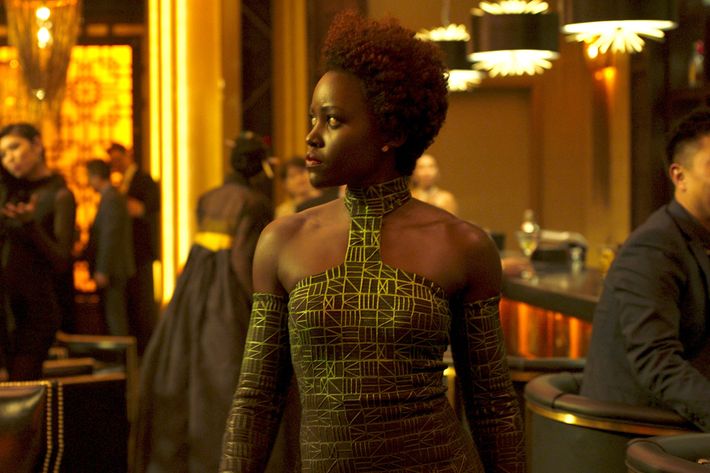
Nakia
We know that Lupita Nyong’o can wear just about anything and make it look stunning, but for the scene where her character Nakia gets dressed up for an undercover mission at a South Korean casino, Carter had to get specific. “It seems as though it would be a sky-is-the-limit thing, but it really isn’t because this is a superhero film and she is a superhero,” said Carter. “There were parameters: She’s entering the casino undercover as an African princess. She has to wear green, because she is a part of the River Tribe. She needs to look elegant, and therefore needs to wear an elegant dress. She also needs to be able to fight, so she needs to have a dress that will allow her to move and to fight.”
Carter settled on a beautiful green-ombre garment with a pattern taken from African trends and printed with raised ink. “So this is an original pattern-and-line work that’s laid and printed on a stretch fabric,” she said. “It’s the same process that we use to print the fabric for the Black Panther suit, and it’s to give her stretch and enough flexibility so that she could fight.” In fact, almost everything that makes the dress so memorable is also meant to gird Nakia for battle. “The armbands kind of inform that she is protecting herself,” said Carter. “And you can imagine that because the dress is from Wakanda, it might have Vibranium laced in it, so we did a metallic paint so that in a certain light really does kind of illuminate. This dress was actually a warrior dress, but it’s in disguise.”
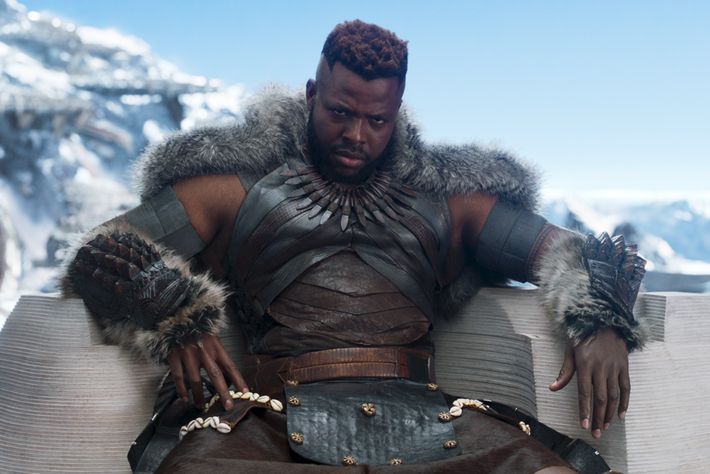
M’baku
Has Black Panther made you a new fan of Winston Duke, who plays mountain-tribe leader M’Baku? You’re not alone: “I was obsessed with him, too!” said Carter. “When I sat through the read-through and heard his character come out, it was such a delight. He’s on the opposite end of the king: He agrees to disagree, and he’s lovable, and he’s also powerful and funny.”
To create this look for M’Baku and the rest of his fictional Jobari tribe, Carter drew from the hillside-dwelling Dogon people of Africa. “They were the first astronomers, and they were very much out on the outskirts of the rest of the country, like the Jobari,” said Carter, who adorned some of M’Baku’s fellow Jobari with Dogon-like grass skirts and added shells to M’Baku’s outfit to signify his wealth, “since shells were a form of currency for many years in Africa.” Carter had a trickier time incorporating M’Baku’s comic-book origins, since he’s based on the character Man-Ape, a dated representation that would not fly in 2018. “It was pretty derogatory and racist, and we didn’t want to go there, but we wanted to honor that he was Man-Ape,” Carter said. “So instead of making his face look like an ape like the comics did, the fur that he has on his shoulders that prominently covers his back is silvery in tone, and represents the silverback ape.”
Duke is six-foot-five and broad, so once he got in the fitting room, Carter kept adding little touches to fill out his big canvas. “Since M’Baku is a person that lives in this cold, smelly place, we kept adding more fur, and I wrapped his arms in it so that it looked like he was keeping warm,” Carter said. There was just one problem: “We couldn’t figure found a way to connect some of the fur so that it would stay up there, because it’s really just sitting on his shoulders, like, by magic. So, we put magnets on him — like, heavy-duty refrigerator magnets — so that piece really stays up there. It’s not moving, but it’s held by magnets.” Take note, cosplayers!

